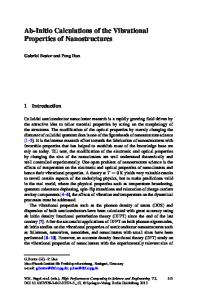Computational generation of disordered structures of Al-12%Si. An ab initio approach
- PDF / 554,315 Bytes
- 6 Pages / 612 x 792 pts (letter) Page_size
- 47 Downloads / 341 Views
1048-Z08-20
Computational generation of disordered structures of Al-12%Si. An ab initio approach. J. Andres Diaz-Celaya1, R.M. Valladares2, and Ariel A. Valladares1 1 Instituto de Investigaciones en Materiales, Universidad Nacional Autonoma de Mexico, Apartado Postal 70-360, Ciudad Universitaria, Mexico D.F., 04510, Mexico 2 Facultad de Ciencias, Universidad Nacional Autonoma de Mexico, Apartado-Postal 70-542, Ciudad Universitaria, Mexico D.F., 04510, Mexico Abstract Metallic glasses are in the forefront of metallurgical research and applications. For this reason it is important to realistically model amorphous metallic systems. Some computer simulation efforts have relied on the use of parameterized classical potentials of the Lennard-Jones type or geometric hard sphere simulations, but first principles approaches have been rarely used. In this work we apply our recently developed ab initio DFT approach (A. A. Valladares et al., Eur. Phys. J. 22 (2001) 443) for the generation of amorphous semiconducting materials, to amorphize an aluminum-silicon alloy, the eutectic Al-12%Si. We report specific atomic structures and radial distribution functions (RDFs), total and partial, of one amorphous and one liquidamorphous periodic cubic supercell of 125 atoms (15 silicons and 110 aluminums), Al-12%Si, with a volume (12.8379 Å)3, generated using the Harris functional. Keywords: Amorphous metallic systems; Liquid metallic systems; a-AlSi; l-AlSi; metallic glasses, Radial Distribution Functions 1. Antecedents Liquid and amorphous metals and binary metallic systems have proven difficult to model. Many-body semiempirical potentials based on the embedded atom method [1], or tight binding methods [2], have been developed to overcome the existing limitations of using pair potentials for describing the metallic bond. Nevertheless some efforts have relied on the use of parameterized classical potentials of the Lennard-Jones type or geometric hard sphere simulations, but first principles approaches have rarely been used. Clearly, knowledge of atomic structures is essential for calculating physical properties from first principles. Aluminum and aluminum alloys are technologically very important and their amorphous forms are being increasingly considered in industry; therefore it is necessary to develop a procedure that will allow the reproduction of the atomic structures of the disordered phases. First principles studies of amorphous and liquid aluminum are scarce. In recent years some ab initio works have appeared that indicate progress along these lines (See [3] and references contained therein). Valladares [4] carried out first principles simulations that led to amorphous, liquid and liquid-amorphous structures of pure aluminum, where the frequently reported bimodal feature of the Radial (Pair) Distribution functions (RDF) is reproduced. The RDFs were obtained for periodic cubic disordered supercells of 108 atoms with volume (12.1485Å)3, generated using the Harris functional. Three processes were studied in the investigation; the fi
Data Loading...









